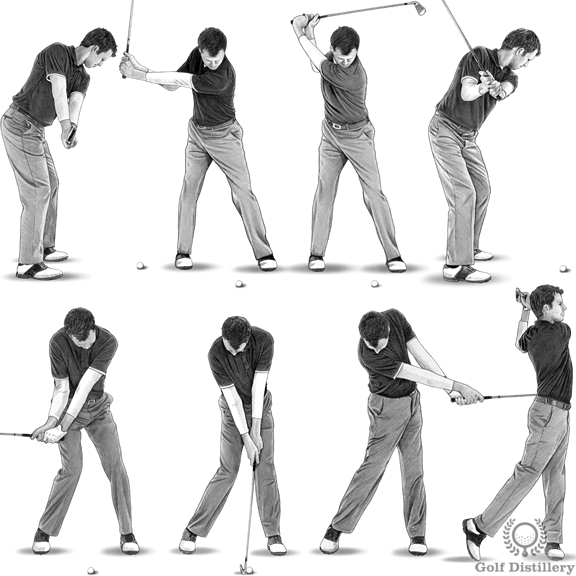If you’re just starting out in the world of golf and looking for some helpful tips to improve your game, you’ve come to the right place! In this article, we will share a handful of beginner-friendly golf tips that will set you on the path to becoming a confident and skilled golfer. Whether it’s mastering your grip, perfecting your swing, or understanding the basic rules of the game, we’ve got you covered. So grab your clubs and get ready to tee off with these valuable pointers that will make your journey into golf an enjoyable one.

1. Choose the right equipment and attire
When it comes to golf, having the right equipment and attire can significantly impact your performance and overall enjoyment of the game. Here are some key factors to consider when selecting your golf clubs, golf balls, shoes, and attire.
1.1 Selecting the right golf clubs
Choosing the right golf clubs is essential for any golfer, whether you are a beginner or an experienced player. It’s important to consider factors such as club length, clubhead design, and shaft flex. For beginners, it is recommended to start with a basic set of clubs that includes a driver, a fairway wood, a hybrid, irons, and a putter. As your skills improve, you can gradually upgrade to more specialized clubs.
1.2 Choosing the appropriate golf balls
Selecting the right golf balls can contribute to your overall performance. As a beginner, you may want to choose a golf ball that offers forgiveness and distance. Look for balls with a soft feel and a low compression rating. These types of balls can help you achieve better control and distance while minimizing the chances of slicing or hooking the ball.
1.3 Wearing comfortable golf shoes
Comfortable golf shoes are crucial for maintaining stability and traction throughout your swing. Look for golf shoes that provide proper arch support, cushioning, and a secure fit. It is also important to consider the type of golf course you will be playing on. Spiked golf shoes are ideal for courses with softer turf, while spikeless shoes are suitable for courses with harder surfaces.
1.4 Dressing appropriately for the weather conditions
Dressing appropriately for the weather conditions is not only important for your comfort but also for your performance on the course. On hot days, opt for lightweight and breathable fabrics that wick away sweat and keep you cool. On cooler days, layer your clothing to adapt to changing temperatures. Additionally, it’s important to follow the dress code of the golf course you will be playing on, which often requires collared shirts and non-denim bottoms.
2. Learn the basic rules and etiquette of golf
Before stepping onto the golf course, it is essential to familiarize yourself with the basic rules and etiquette of golf. This knowledge will not only help you avoid penalties but also ensure a smooth and enjoyable experience for yourself and others.
2.1 Familiarizing yourself with the rules of the game
Golf has its own set of rules that govern the game. Familiarize yourself with key rules such as out of bounds, lost ball, and penalty strokes. Understanding these rules will help you make informed decisions during your round and avoid unnecessary penalties. It is also beneficial to familiarize yourself with specific rules that may be unique to the course you are playing on.
2.2 Knowing golf course etiquette
Golf course etiquette is a set of unwritten rules that govern player behavior on the course. Respecting these guidelines not only shows courtesy to fellow players but also helps maintain the course’s integrity. Some common etiquette practices include repairing divots, raking bunkers, and keeping noise to a minimum during a player’s swing. Additionally, it is important to maintain a reasonable pace of play and allow faster groups to play through when necessary.
2.3 Understanding common golf terms and phrases
Golf has its own language, and understanding common terms and phrases will help you communicate effectively with other players and professionals. Learn terms such as birdie, bogey, par, and eagle, which refer to specific scores on individual holes. Familiarize yourself with golf slang, such as “fore” to warn others of an errant shot, and “mulligan” to describe a do-over shot. Understanding and using these terms will enhance your overall golfing experience.
3. Develop a consistent and solid grip
The grip is one of the fundamental aspects of your golf swing and has a significant impact on the direction and control of the ball. Mastering a consistent and solid grip is crucial for improving your game.
3.1 Understanding the importance of grip
The grip is the only physical connection between you and the golf club. It plays a vital role in controlling the clubface and ultimately the direction of the ball. A proper grip allows for a more natural and efficient release of the club, leading to better consistency and accuracy in your shots.
3.2 Learning the proper grip technique
To achieve a proper grip, start by placing the club in your left hand (for right-handed golfers) with the clubface square to the target. Position your left hand on the grip with the thumb pointing down the shaft. Wrap your fingers around the club, making sure there is no tension or excessive pressure. Then, position your right hand below your left hand, making sure the palms are facing each other. The right pinky should overlap the gap between the left index and middle finger. Again, ensure a relaxed and comfortable grip.
3.3 Practicing grip pressure and hand placement
Finding the right amount of grip pressure is crucial. Avoid gripping the club too tightly, as this can restrict your swing and lead to tension in your hands and arms. Instead, aim for a grip pressure that allows you to maintain control of the club while remaining relaxed. Additionally, pay attention to the placement of your hands on the grip. Consistency in hand placement will help promote a repeatable swing.
4. Master the fundamental golf stance and posture
A proper golf stance and posture are essential for maintaining balance, stability, and power throughout your swing. Mastering these elements will help optimize your swing mechanics and improve your overall performance.
4.1 Achieving the correct golf posture
Achieving the correct golf posture starts with a straight back. Bend from your hips, not your waist, keeping your spine in a neutral position. Your knees should be slightly flexed, and your weight should be evenly distributed between your feet. The width of your stance will vary depending on the club you are using, with narrower stances for shorter clubs and wider stances for longer clubs. Maintain a relaxed and athletic posture to allow for a fluid and powerful swing.
4.2 Maintaining balance and alignment
Maintaining balance is crucial for a stable swing. To achieve proper balance, keep your weight centered and distribute it evenly between your feet. Avoid leaning too far forward or backward during your swing. Additionally, ensure proper alignment by positioning your feet parallel to the target line. Align your hips and shoulders with your feet to maintain proper alignment throughout your swing.
4.3 Positioning your feet and body correctly
Proper foot and body positioning are key factors in achieving a consistent and powerful swing. Position your feet shoulder-width apart, with the ball positioned slightly forward of center in your stance. Align your toes, knees, hips, and shoulders parallel to the target line. Avoid any excessive tilt or sway in your body and maintain a stable foundation throughout your swing.

5. Focus on proper alignment and aim
Aligning yourself correctly to the target and setting up the ball position appropriately are crucial for hitting accurate shots. By focusing on proper alignment and aim, you can improve your consistency and increase the chances of hitting your desired target.
5.1 Aligning your body parallel to the target line
To achieve proper alignment, imagine a target line extending from your ball to your intended target. Position your feet, hips, shoulders, and clubface parallel to this target line. Use alignment sticks or markers on the ground to assist with alignment during practice sessions. Consistent alignment will help you establish a reliable and repeatable swing path.
5.2 Setting up the correct ball position
The ball position varies depending on the club you are using and the type of shot you want to hit. For most irons, the ball should be positioned slightly forward of center in your stance. With longer clubs, such as drivers and fairway woods, the ball should be positioned further forward in your stance. Experiment with different ball positions during practice sessions to find the optimal position for each club in your bag.
5.3 Aiming with the clubface
Once you have aligned your body parallel to the target line, it’s important to ensure that the clubface is also aimed correctly. Align the leading edge of the clubface perpendicular to the target line. Use intermediate targets, such as a spot on the ground, to align the clubface accurately. By focusing on aligning both your body and the clubface, you can increase your chances of hitting accurate shots consistently.
6. Develop a smooth and consistent golf swing
Developing a smooth and consistent golf swing is a continuous process that requires practice and refinement. By focusing on the basic components of a golf swing and maintaining proper tempo and rhythm, you can improve the mechanics of your swing and enhance your overall performance.
6.1 Understanding the basic components of a golf swing
A golf swing consists of several key components, including the grip, the setup, the backswing, the downswing, and the follow-through. Each component plays a crucial role in the overall mechanics of the swing. Understanding the purpose and importance of each component will help you develop a more efficient and consistent swing.
6.2 Practicing the backswing and downswing
The backswing is the initial motion of the golf swing and sets the foundation for the downswing. During the backswing, focus on turning your shoulders and coiling your body while maintaining a stable lower body. Avoid excessive tension and maintain a smooth and controlled backswing. The downswing is the transition from the backswing to impact, where the clubhead accelerates and strikes the ball. Practice maintaining a balanced and controlled downswing, with a gradual increase in clubhead speed and a solid strike on the ball.
6.3 Maintaining proper tempo and rhythm
Proper tempo and rhythm are essential for a smooth and consistent golf swing. Tempo refers to the speed and timing of the swing, while rhythm refers to the overall flow and sequencing of the swing. Aim for a balanced and unhurried tempo, with a smooth transition from the backswing to the downswing. Maintain a consistent rhythm throughout your swing to promote better timing and synchronization of your body and club.

7. Start with shorter shots and gradually work your way up
When learning golf, it is important to start with shorter shots and gradually work your way up to longer shots. Mastering the art of chipping, practicing pitch shots, and gradually advancing to longer shots will help build a solid foundation and increase your confidence on the course.
7.1 Mastering the art of chipping
Chipping is a short, controlled shot typically used around the green. Mastering this shot is vital for getting the ball close to the hole and saving strokes. Focus on using a consistent and repeatable motion, with a slight downward strike on the ball. Practice different chipping techniques, such as using a sand wedge or a pitching wedge, to develop a versatile short game.
7.2 Practicing pitch shots
Pitch shots are medium-length shots used to cover a greater distance than a chip shot. These shots require a slightly longer swing and often involve lofted clubs, such as a sand wedge or a lob wedge. Practice controlling the distance and trajectory of your pitch shots by varying the length of your swing and club selection.
7.3 Gradually advancing to longer shots
Once you have developed confidence and consistency with shorter shots, gradually advance to longer shots. Start by practicing with mid-irons, such as a 7-iron or an 8-iron, and gradually work your way up to longer irons and fairway woods. Focus on using the fundamentals you have learned, such as proper grip, stance, alignment, and swing mechanics, to maintain consistency throughout your bag.
8. Learn how to putt effectively
Putting is often considered one of the most critical aspects of the game, as it accounts for a significant portion of your total score. By mastering the basic putting grip, practicing distance control, and understanding green reading, you can become a more effective putter.
8.1 Mastering the basic putting grip
The putting grip differs from the full swing grip and is often referred to as the “reverse overlap” or “cross-handed” grip. Experiment with different grips to find the one that feels most comfortable and provides stability and control. The grip should promote a pendulum-like motion with minimal hand and wrist movement.
8.2 Practicing distance control
Distance control is essential for accurate putting. Practice different-length putts on a practice green to develop a feel for various distances. Focus on your tempo and rhythm, and aim to roll the ball consistently to your intended target. Developing a consistent stroke length for different distances will help improve your overall distance control.
8.3 Understanding green reading
Green reading refers to the process of analyzing the slope, speed, and grain of the putting surface to determine the ideal path and speed for your putt. Look for subtle slopes and breaks in the green by observing the surrounding terrain. Pay attention to shadow patterns and the grain of the grass, as they can influence the direction and speed of your putt. Practice reading greens by visualizing the ball’s path and aiming points along your intended line.

9. Utilize practice drills and exercises
Incorporating practice drills and exercises into your training routine can help reinforce proper fundamentals, improve specific aspects of your game, and enhance your overall performance on the course.
9.1 Incorporating alignment and aim drills
Alignment and aim drills are an effective way to reinforce proper alignment and aim habits. Use alignment sticks or markers on the ground to simulate the target line and practice aligning your body and clubface correctly. Incorporate drills that focus on aligning your feet, hips, and shoulders to the target line and develop muscle memory for consistent alignment.
9.2 Practicing swing tempo and rhythm drills
To develop a smooth and consistent swing tempo and rhythm, incorporate drills that specifically target these aspects of your swing. Practice swinging with a metronome or a rhythm trainer to establish a consistent tempo. Focus on maintaining a balanced and unhurried swing throughout the drill. Additionally, use a mirror or video recording to analyze your swing and ensure optimal rhythm and timing.
9.3 Using training aids for specific aspects of the game
Training aids can be valuable tools for targeting specific aspects of your game. Utilize aids such as putting alignment tools, swing training devices, and impact bags to enhance your practice sessions. These aids can provide immediate feedback and help you correct flaws in your technique. However, it is important to use training aids as supplemental tools and not rely solely on them for improvement.
10. Seek professional guidance and take golf lessons
To accelerate your progress and ensure proper technique, it is beneficial to seek professional guidance and take golf lessons. A qualified golf instructor can provide personalized feedback, identify areas for improvement, and help you develop a tailored practice plan.
10.1 Finding a qualified golf instructor
When looking for a qualified golf instructor, consider their experience, certifications, and teaching style. Seek recommendations from fellow golfers or inquire at your local golf course or driving range. Look for instructors who have a proven track record and a patient and supportive teaching approach.
10.2 Taking advantage of group or individual golf lessons
Group or individual golf lessons offer different benefits depending on your learning preferences and goals. Group lessons provide a social and interactive learning environment, allowing you to learn alongside other golfers of a similar skill level. Individual lessons offer personalized attention and allow the instructor to focus solely on your specific needs and areas for improvement. Consider your learning style and schedule when deciding which type of lesson is best for you.
10.3 Utilizing technology for swing analysis and improvement
Technology can play a valuable role in analyzing and improving your golf swing. Many instructors utilize video analysis software, launch monitors, and swing tracking devices to provide detailed feedback on your swing mechanics. Embrace these technological advancements as they can help you visualize and better understand the areas for improvement in your swing. Work with your instructor to leverage technology effectively and enhance your practice sessions.
By following these beginner-friendly golf tips, you can establish a strong foundation for your golfing journey. Remember to be patient, practice regularly, and always prioritize enjoyment and sportsmanship on the course. With time and dedication, you will see improvement in your game and find the joy and satisfaction that golf has to offer. Happy golfing!







